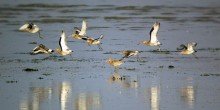February was quietly working its way towards spring with some spring-like weather in amongst the usual rainy days and then it all changed! The wind swung round and instead of the normal mild westerlies we get it came in from the east, direct from Siberia. Termed the ‘beast from the east’ by the popular press it brought sub-zero temperatures for a few days along with the first snowfall in Dorset for a couple of years. This cold snap certainly stirred up the bird activity and also the activity of those who watch them!
The highlight of the month was undoubtedly the appearance in and around Weymouth of a single Ross’s gull. Ross’s gull is a native of the Siberian Arctic and is known to normally not travel far even in winter and so one in the south of England was what could truly be described as a rarity and brought bird watchers from all over the country to see it. It had obviously been brought this way by the strong easterly wind. It stayed for a few days and was still present as we entered March. It was quite mobile being seen at Ferrybridge, Radipole, Lodmoor and out in Weymouth bay. At Radipole it even joined the other gulls on the car park at times!
The easterly wind and extreme weather further north brought a collection of other gulls to the Dorset shores including at least three glaucous gulls; very large birds known as ‘white wingers’ as they do not have the black wing tips that many species of gull have. As well as the glaucous there were records of Caspian gull, little gull and a single record of a Kumlein’s gull – all notable records.
Also at sea great northern divers and black-necked grebes seemed to be about in good numbers with one great northern diver setting up home on the boating lake in Poole Park and creating a lot of interest! The were also records of black-throated and red-throated divers, red-necked and Slavonian grebes and a velvet scoter. The velvet scoter was a regular in Poole Harbour during the month.
On land things were much quieter. The hawfinch invasion was still apparent but the numbers seemed to be dropping as the month progressed. Fircrest were still seen in good numbers and there were records of Siberian chiffchaffs and one yellow-browed warbler. The stilt sandpiper was around Christchurch Harbour, mainly Stanpit Marsh, for several days but seemed to disappear with the arrival of the wintry weather.
Before the cold spell some recorders were beginning to put out their moth traps and it is surprising what can be found in February. The most notable was a red-headed chestnut moth, once a rare migrant but now being seen here more frequently. Ten species were recorded in all and the full list can be found in the February records list on the Nature of Dorset. On the early spring-like days brimstone, red admiral and peacock butterflies were seen. These would be hibernating specimens woken up by the milder weather.
The records list also includes ten species of mammals and three reptiles, the most notable being adders basking in the sun at Durlston and an otter out by day near Blandford. One recorder also had the treat of finding a dormouse in a nesting box whilst helping out on a winter survey looking for hibernating animals.
The full effects of the very cold snap will be felt during the early days of March as birds are driven south in search of food from the frozen north.
More details about the nature of Dorset in February can be found here:
https://www.natureofdorset.co.uk/records-diary/february-2018
Peter Orchard







